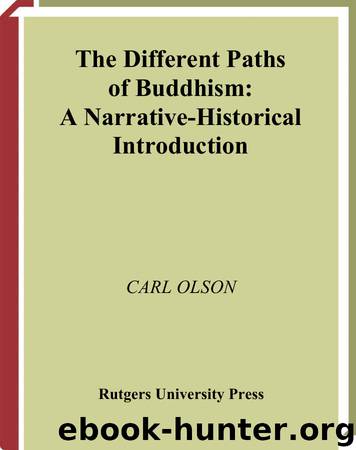The Different Paths of Buddhism by Carl Olsen

Author:Carl Olsen [Olsen, Carl]
Language: eng
Format: epub
Published: 2011-02-17T05:00:00+00:00
robin-bobin
PART THREE
Major Maha¯ya¯na Movements
and Schools
robin-bobin
robin-bobin
8
The Bodhisattva’s Path to Perfection
While the Buddha was alive, his voice was considered authoritative. When a problem arose with respect to monastic discipline, for instance, his monks would simply turn to him for a ruling. In the formative period, the monastic order recognized the right to schism and protected this right. Even though in principle the intention to create a schism was not condemned by the early tradition, the dishonest intention to produce a split in the order was condemned. Therefore, the right to produce a split in the order was a moral and not a legal right.
A valid schism could be initiated by a minimum of nine qualified members of the monastic order. A smaller number, it was said, only created disunion. During the early history of Buddhism, it was not uncommon to have schismatic groups residing within the original monastery, although the groups would hold separate assemblies. It was possible for a schismatic group eventually to develop into a school ( v a da), which would sometimes necessitate a new edition of the scriptures according to their dissident doctrines and discipline.
Early councils and schisms marked the early history of Buddhism. According to tradition, the first council was allegedly held at Rajagrha after the death of the Buddha, in order to establish the authoritative teachings and discipline. At this time the tradition was divided into two “baskets” ( pi t akas), and eventually a third was added. These collections included the discourses of the Buddha, monastic rules, and the Abhidhammma or higher teachings. The third and final collection of teachings probably represents an attempt over a long period of time to sys-tematize philosophically lists and summaries of topics for discussion and analysis.
Approximately one hundred years after the Buddha’s death, a second council was held at Vaizali because of disputes about monastic rules. This council resulted in a split of the community into two sects: Sthaviras (Elders) and MahasaNghikas (Great Assembly). The former group claimed to preserve the genuine teachings and discipline of the Buddha, and emphasized the importance of monastic life for genuine practice of the religion and eventually enlightenment.
1 4 3
Download
This site does not store any files on its server. We only index and link to content provided by other sites. Please contact the content providers to delete copyright contents if any and email us, we'll remove relevant links or contents immediately.
The Way of Zen by Alan W. Watts(6477)
Ego Is the Enemy by Ryan Holiday(5263)
The Art of Happiness by The Dalai Lama(4047)
The Book of Joy by Dalai Lama(3879)
Why Buddhism is True by Robert Wright(3387)
Spark Joy by Marie Kondo(3227)
Shift into Freedom by Loch Kelly(3121)
Happiness by Matthieu Ricard(2974)
A Monk's Guide to a Clean House and Mind by Shoukei Matsumoto(2854)
The Lost Art of Good Conversation by Sakyong Mipham(2546)
The Meaning of the Library by unknow(2485)
The Unfettered Mind: Writings from a Zen Master to a Master Swordsman by Takuan Soho(2234)
The Third Eye by T. Lobsang Rampa(2213)
Anthology by T J(2149)
Red Shambhala by Andrei Znamenski(2132)
The Diamond Cutter by Geshe Michael Roach(2007)
Thoughts Without A Thinker: Psychotherapy from a Buddhist Perspective by Epstein Mark(1949)
Twilight of Idols and Anti-Christ by Friedrich Nietzsche(1837)
Advice Not Given by Mark Epstein(1827)
